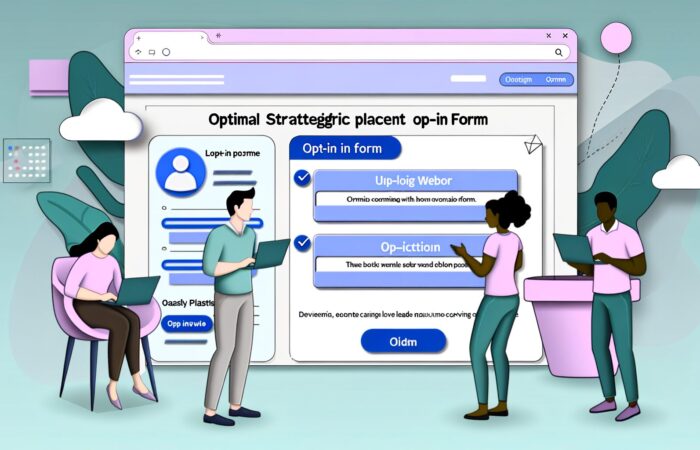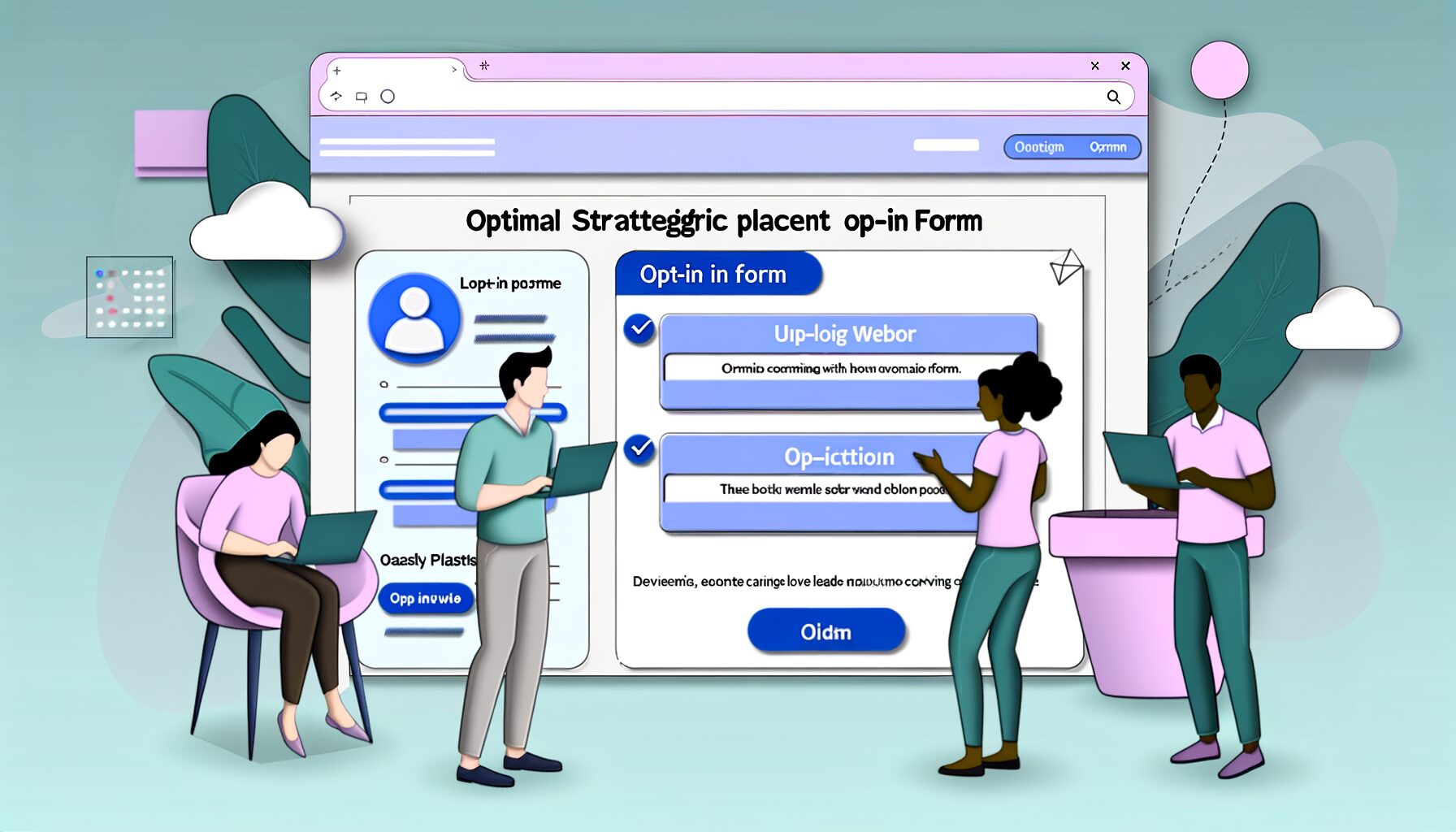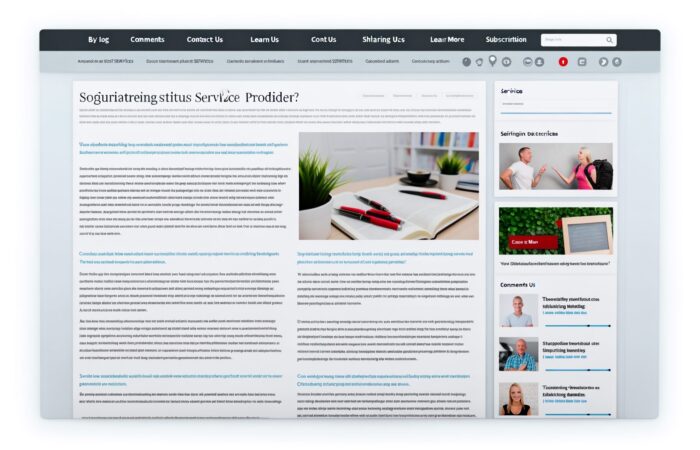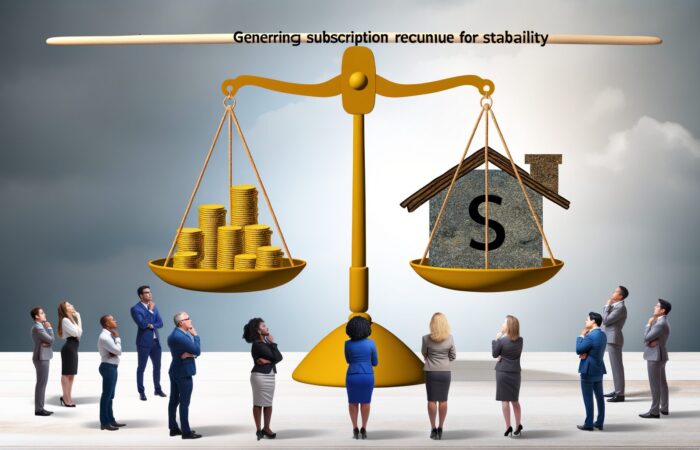Let’s dive into the world of Opt-In Forms and uncover the magic behind boosting your website’s conversion rates. Whether you’re just starting out or looking to refine your tactics, understanding the nuts and bolts of opt-in forms can be a game changer for your online presence.
What is an Opt-In Form?
An opt-in form is your golden ticket to turning website visitors into committed members of your community. It’s basically a form where visitors willingly give you their email addresses, often in exchange for something valuable like newsletters, free trials, or exclusive content. The key here is ‘willing’ — you’re not just collecting emails, you’re building a relationship.
Why Focus on Conversion Rates?
Imagine this: you have a bustling city, and you want more tourists to visit your newest theme park, Website Wonderland. Now, your opt-in form is like an inviting brochure counter. The more effectively it’s positioned and styled, the more tourists you’ll get lining up for tickets! Similarly, the better your opt-in form engages your website visitors, the higher your conversion rates climb. Higher conversion rates mean more sign-ups, more engagement, and ultimately, higher revenues.
Opt-In Forms & Your Business Goals
Running a blog? An engaging newsletter might be your golden egg. Launching a new product? Exclusive early access can make your audience feel special. In every scenario, your opt-in form serves as the critical connection between your site visitors and your service offerings. What do you want them to do? Think about that, and let your objectives guide the form’s design and message.
Tips for Crafty Conversion Tactics
- A Clear Value Proposition: Let visitors know exactly what they’ll get by signing up. Be specific and irresistible!
- Minimalistic Design: Keep it simple, silly! A clutter-free form with a friendly, human-touch can work wonders.
- Strategic Placement: Don’t hide your brochure counter in the back alley. Place your opt-in forms where eyes naturally go. Spoiler alert: We’ll dive deeper into placement strategies later!
Making the Form Unmissable
An effective opt-in form doesn’t play hide and seek with visitors. It stands proud, catches the eye, and yet doesn’t interrupt the natural browsing experience. It’s about striking the right balance — noticeable without being nudging.
Remember, the goal is to craft an opt-in form that doesn’t just exist, but excels in fulfilling your business’s unique goals. It’s about making the first handshake count, and ensuring it opens the door to a lasting relationship.
Last Piece of Advice
Ready to boost those opt-in metrics? Start with these foundational insights, and use them to refine your strategy continually. Experiment boldly, measure religiously, and keep what works best. Here’s to more “sign-ups” in that inbox of yours!
Understanding Website Visitor Behavior
Alright, let’s dive into the fascinating world of website visitor behavior. Understanding how and why visitors interact the way they do on your site isn’t just intriguing; it’s crucial for maximizing the effectiveness of your opt-in forms. So, let’s pull back the curtain and see what’s going on behind the scenes!
Why Visitors Do What They Do
Ever wondered why some visitors fill out your forms like there’s no tomorrow while others shy away as if the form were a spider web? Well, it’s all about user intent and experience. Insights into these can significantly lift the veil on how to capture those elusive email addresses more effectively.
- User Intent: This revolves around why someone visits your site. Are they here to browse, learn, or make a purchase? Tailoring your approach based on this intent can make all the difference.
- User Experience: How easy and enjoyable is your website to use? Clunky forms and hard-to-navigate layouts are major roadblocks. A seamless experience helps smooth the path right to your opt-in form.
Tracking Tools and Tricks
You’re not a mind reader, but with the right tools, you almost could be. Utilizing tools like heatmaps or analytics software provides a window into how visitors interact with your site. Do they scroll all the way down where your seasoned form awaits? Or do they jump ship before they even see it?
The Pattern of Clicks and Scrolls
Analysis paralysis—is what happens next after presenting users a whirlwind of options. Surprisingly, behaviors like which buttons get clicked and where visitors lose interest can provide a goldmine of insights. Patterns that emerge from such interactions can guide not just where to place your opt-in forms but how to design them.
Real-Life Visitor Scenarios
We love examples, don’t we? Imagine this:
- The Quick Browser: Barely touching the surface of your content and bouncing? Speedy design elements like pop-ups might work here.
- The Engaged Reader: This user digs deep into articles. Placing an opt-in form mid-article or at the end can yield impressive results for this crowd.
- The Comparison Shopper: Always toggling between tabs? Piquant and straightforward benefits highlighted in your forms can keep them focused and ready to convert.
Drawing Conclusions
Gaining insights into visitor behaviors isn’t just wildly interesting—it’s absolutely game-changing for your conversion rates. So, roll up your sleeves, analyze patterns, test different strategies, and always aim to provide a smoother user experience. Your opt-in rates will thank you, and frankly, understanding your audience is never a wasted effort, right?
Keep treading through the knowledge swamp of visitor behavior—it’s filled with the treasures of understanding that lead to conversion gems!
Best Locations for Opt-In Forms on Your Website
Imagine a bustling virtual city – that’s your website. And just as cities place billboards in prime spots to catch the eye, the positioning of your opt-in forms can make all the difference in whisking website visitors off their feet to sign up smilingly. Let’s take you through the neighborhood of top-performing spaces for your opt-in forms.
Above the Fold
First off, ‘Above the fold’ refers to the portion of your website visible before the reader scrolls down – it’s like the window display of your site. Keeping an opt-in form here guarantees immediate visibility when someone lands on your website. Quick tip: make sure it’s non-intrusive yet noticeable with an inviting call to action!
At the End of Blog Posts
Already interested in the delicious content you’ve served? What better time to pop the question! Tailor an opt-in form related to the topic of the blog and place it subtly at the end. Putting an opt-in after your insightful blogs can gently nudge readers, showing eagerness for more without being too pushy.
Sidebar City
The sidebar doesn’t have to be the quiet wallflower at your website party. Decking out this area with a suave opt-in form can catch visitors’ eyes as they glance around, similar to scanning posters on a community notice board.
As a Floating Bar
An ever-present floating bar is like that friend who’s always gently reminding you about cool opportunities to grab. Position them at the top or bottom of the site they scroll along with the reader. This method makes sure your friendly form reminder is always in sight, not out of mind. Just don’t make it too clingy; subtle but noticeable is your mantra here.
Your Website’s 404 Pages
Turn lost visitors into opportunities by placing opt-in forms on your 404 error pages. Soften the ‘Oops, wrong turn!’ moment with a helpful opt-in form suggesting they sign up to get back on track. It’s like handing them a helpful map when they feel lost in your city of content.
Within Your “About Us” Page
Enthusiasts venturing to your About Us page are liking what they see and want to know more. Why not captivate this captive audience’s interest by placing an opt-in form amidst your story? Similar to ringing up to say how much you enjoyed your friend’s anecdote and would like to stay tuned for more, an opt-in here says, ‘Let’s stay in touch!’
In Summary
Putting your opt-in forms in the right spots across your website isn’t just about getting numbers up – it’s about creating effortless connective moments with visitors who are most likely to become more than digital passer-bys. Envision these strategic placements as pinning your virtual flyers where they’re most likely to be interestingly found and fondly noticed. Experiment, monitor, and adjust – and those opt-ins will be saying – ‘Oh, hello there!’ in no time.
Timing and Triggers: When to Present Opt-In Forms
So, you’ve already nailed down where to put your opt-in forms on your website, and that’s fantastic! Now, let’s add another layer to that cake – timing. Because, let’s face it, hitting your visitors with an opt-in form too soon might be a bit forward, whereas too late might mean missed opportunities.
Ever been to a dinner party and someone you’ve just met invites you into their life story? Overwhelming, right? Similarly, presenting an opt-in form when a visitor lands on your page might be too soon. You haven’t wooed them yet! First impressions matter, and making sure your readers have some time to breathe and understand what your site is about can really set the tone.
Getting the Timing Just Right
Here’s the sweet spot: triggering an opt-in form based on user behavior. This could mean a number of things:
- Time on page: You could set up your form to appear after a set amount of time. This gives the user a chance to get acquainted with your content. Rule of thumb? Gently slide into their view after they’ve spent 30 seconds or more on a page.
- Scroll depth: Ah, now this one’s golden. Have an opt-in form make its grand entrance once a visitor has scrolled through a specific percentage of the page (say 60-70%). This shows interest in your content. “Hello! Fancy seeing you scroll down here! Got more goodies if you subscribe!”
- Exit-intent: This is like catching them just before they leave the party. When your visitor’s mouse goes all the way up to leave the page, that’s when you pop the question! “Before you go, can I interest you in our weekly updates?” It’s your last chance saloon – make it count!
Consider Your User’s Journey
Think about where your visitor is in their journey on your site. If they’re checking out your latest blog post, that might not be the best time to ask them to subscribe to your product updates — they might not even know who you are yet! Instead, weave contextual invites into the user experience. For example, in a relevant blog post, consider mentioning a free guide closely related to the topic, delivered straight to their inbox upon subscription. Now, that’s smart and considerate marketing!
Actionable Triggers
Transitioning from simply a page visitor to an email subscriber should be effortless and almost instinctual. Some additional smart triggers you could use:
- Completion of an engaging quiz on your site where the results are sent via email.
- Reader reaches the end of an article and you offer a “Read More” series exclusive for subscribers.
- Launch of a new product or feature announcement where early access is given to email list members.
Deploying these strategic and courteous opt-in invitation methods ensures you not only respect your user’s online space but enhances the chance that they will want to engage more deeply with your content. Remember, it’s not just about having a guest at the table, but about making them feel welcome and stitches Discovery into their visit!
Design Elements that Encourage Opt-In Form Conversions
So, now that we’re dialing into what makes your visitors tick, let’s chat about how to catch their eye and coax them into action with smart design tricks. Trust me, a little flair here and a splash of color there can significantly bump up those opt-in stats!
1. Say It With Color
Bold and vibrant colors can be your best friends when it comes to opt-in forms. They’re not just pretty to look at; colors like red, green, or even orange tend to encourage more clicks by standing out on the page. However, the trick lies in making sure the colors align with your website’s overall theme and are comfortable for the eyes. A neon yellow form on a delicate pastel website? Not so soothing.
2. Clear, Compelling Call-to-Actions
This is where you tell your visitors what to do. Instead of the generic ‘Submit’, why not spice up your call-to-action (CTA) buttons with phrases like ‘Get My Free Ebook’ or ‘Yes, Send Me Tips!’? It adds a pinch of personality and clarity. Visitors should feel excited about what they’re about to receive, and the right verb can make a world of difference.
3. Keep It Simple
Nobody wants to wrestle with a confusing form. Aim for simplicity – not just in design but in information collection. Ask yourself, do you really need their second cousin’s roommate’s maiden name? Stick to what’s essential: perhaps just their email address and first name. Simplifying your forms ensures users won’t abandon your sign-up process halfway through out of frustration.
4. Use Friendly Typography
Typefaces set the tone of your written content. Opt for legible, web-friendly typography that welcomes visitors instead of chasing them away. Remember, if they can’t easily read your form, they won’t fill it out. Sans-serif fonts like Arial or Verdana are generally a safe bet. They’re easy on the eyes, simple, and effective.
5. Play with Placement
Whether your opt-in form is a bold pop-up or a sleek sidebar, where it lives on your page can affect how many eyes it catches. For instance, a form immediately visible when a visitor lands on your site (above the fold) could perform better than something they need to scroll to find. Try different placements and see where it strikes the right note!
6. Images and Icons
Lastly, don’t overlook the power of visuals. Adding an engaging image or on-point icon can amplify the impact of your opt-in forms. These can include arrows pointing to CTAs or pictures of people supposedly benefiting from an offer. Humans are visual creatures, and the right image could be just what’s needed to turn a maybe into a yes.
In essence, the design of your opt-in forms shouldn’t be an afterthought. Each element from color and text to imagery and localization plays a pivotal role in converting a visitor into a subscriber. Reflect deeply on these factors, test diligently, and watch your opt-in rates not merely climb but soar!
A/B Testing Strategies for Opt-In Form Placement
Now, let’s dive into the art (and science) of A/B testing to find that sweet spot for your website’s opt-in forms. Imagine A/B testing as your digital form of “Hide and Seek.” We place the opt-in form in various spots, ask users to find it (by hopefully opting in!), and then track which spot gets the most engagements. It’s fun, and oh, so revealing!
Setting Up Your First A/B Test
First things first, you gotta set up your experiment correctly. Choose two designs or placements you want to test against each other – let’s call them Version A and Version B. Maybe Version A is at the top of your sidebar while Version B pops up after a user spends a minute on the page. The goal? To see which version causes more users to subscribe or engage.
Example Time!
Imagine you run a blog about sustainable living, and you’re trying to capture email addresses to send more green tips. For Version A, you could place an opt-in form in the header. For Version B, maybe try a slide-in form that appears when a user scrolls halfway through an article.
Monitoring and Measuring Results
With A/B testing, it’s all about the numbers. Keep track of key metrics:
- Conversion Rate: The percentage of visitors who fill out the form.
- Bounce Rate: How quickly do users leave your site after seeing the opt-in form?
- Time on Page: Do certain forms keep users engaged longer?
Measure the performance of each variant by using tools like Google Analytics or Optimizely. These tools take guesswork out of the equation and serve you hard data for informed decision-making.
Making Data-informed Decisions
After a couple of weeks of testing (yes, patience is key!), assess the results. If Version A outperformed Version B significantly, then your choices become clearer. But what happens when there’s no clear winner, or if the results are too close to call? Well, that’s when multiple rounds of testing come into play. Test new elements like form colors, button sizes, or call-to-action texts to find your magic formula.
It’s All About Iteration
Last bit of friendly advice – don’t stop at one successful test. The digital landscape is always evolving, and so are user behaviors. Regular A/B testing supports continuous improvement. Remember, each change is an opportunity to learn more about your visitors and hone your opt-in strategy.
Kicking Your Opt-In Strategy into High Gear
In the realm of digital marketing, perfecting your opt-in form’s placement is crucial. By using a systematic approach through A/B testing, not only do you enhance user experience by positioning elements where they are most effective, but you also increase your chances of conversion. It’s a win-win!
Leveraging Analytics to Optimize Opt-In Form Placement
So, you’ve designed some pretty slick opt-in forms and scattered them across your website – that’s great! But how do you know if they’re in the best possible spots to maximize conversions? Enter the superhero team of the digital marketing world: web analytics.
Web analytics are crucial because they tell the story of how visitors interact with your site. Think of analytics like breadcrumbs showing where visitors have been, what they liked, and where they said, “Nope, not for me!” By diving into this data, you can start making informed decisions about where to locate your opt-in forms for maximum effect.
First off, it’s key to understand the basic metrics you should monitor:
- Conversion Rates: How many visit -vs- how many opt-in.
- Bounce Rates: Are visitors leaving quickly without engaging?
- Traffic Sources: Knowing where your visitors come from can help tailor your forms to specific audiences.
- Page Popularity: Which pages capture the most attention?
With these metrics on your side, you can start to see patterns form. For instance, if a page has high traffic but low conversions, it might be time to reevaluate either the placement or design of your opt-in form.
Finding Goldmines with A/B Testing
However, analytics give you more than just passive insights; they fuel proactive tests. Particularly, A/B testing is your best friend when it comes to fine-tuning. By creating two versions of the same page — each with the opt-in form in different locations — you can let your visitors tell you which one they prefer by their actions. It’s like letting them vote with their clicks, and often, the results are quite enlightening!
Using Heatmaps for a Warmer Reception
Beyond traditional analytics, heatmaps can be a game-changer. These nifty tools show you a visual map of where people are clicking on your page, and often where they hover their mouse (which indicates interest). Not seeing much action around your opt-in form? Maybe it’s time to move it to one of those “hotter” areas where users are more engaged.
Continually Adapt and Enhance
The journey doesn’t end there. Optimal placement today may not be as effective tomorrow. Internet user’s behaviors evolve, trends shift, and your website updates. That’s why it’s essential to keep an ongoing tab on your analytics. Make it a regular ritual to check how forms are performing and experiment regularly based on updated data. Finally, never let the fear of change stop you—sometimes, the best results come from the most unexpected adjustments!
In conclusion, leveraging analytics isn’t just about understanding visitor behavior—it’s about responding to it creatively and strategically. Keep your finger on the pulse of your data, embrace the experimental spirit of A/B testing, and keep adapting. Stay curious, keep iterating, and watch your conversions grow!











No Comment! Be the first one.